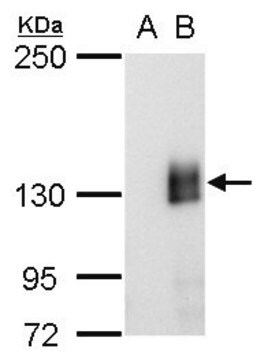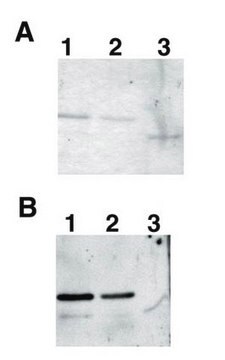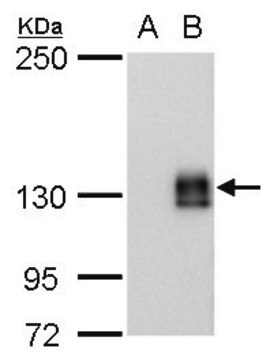AB356482
Anti-mCherry
from rabbit
Synonym(s):
Anti-mCherry Antibody
Sign Into View Organizational & Contract Pricing
All Photos(3)
About This Item
UNSPSC Code:
12352203
eCl@ss:
32160702
NACRES:
NA.41
Recommended Products
biological source
rabbit
Quality Level
antibody form
affinity isolated antibody
antibody product type
primary antibodies
clone
polyclonal
species reactivity (predicted by homology)
all
technique(s)
immunofluorescence: suitable
western blot: suitable
isotype
IgG
UniProt accession no.
shipped in
ambient
target post-translational modification
unmodified
General description
mCherry, red fluorescent protein, is derived from DsRed, a red fluorescent protein from disc corals of Discosoma species. DsRed is similar in size and other properties to GFP, but it produces a red rather than a green fluorescence. mCherry is a monomeric form that has been engineered with multiple cycles of mutation, directed modification and evolutionary selection. It exhibits excitation maximum at 587 nm and an emission maximum at 610 nm with a fluorescent quantum yield of 0.22. mCherry displays high photostability and resistant to photobleaching. It also displays improved brightness and extremely rapid maturation rate. Anti-mCherry, polyclonal is an affinity purified antibody that recognizes mCherry in HEK293 cells transfected with pFin-EF1-mCherry. (Ref.: Schaner, NC et al. (2004). Nat. Biotechnol. 22(12):1567-72; Gross, LA et al. (2000). Proc. Natl. Acad. Sci. USA. 97(22):11990-95).
Specificity
This polyclonal antibody detects mCherry in HEK293 cells tranfected with pFin-mCherry.
Immunogen
Epitope: unknown
His-tagged full length recombinant mCherry from Discosoma sp (Mushroom anemone).
Application
Detect mCherry protein using this rabbit polyclonal anti-mCherry Antibody, Cat. No. AB356482. It has been tested in Immunofluorescence and Western Blotting.
Immunofluorescence Analysis: A 1:500 dilution from a representative lot detected mCherry in HEK293 cells transfected with pFin-EF1-mCherry vector. (Courtesy of Dr Gerry Shaw).
Western Blotting Analysis: A 1:1,000 dilution from a representative lot detected mCherry in HEK293 cells transfected with pFin-EF1-mCherry vector. (Courtesy of Dr Gerry Shaw).
Western Blotting Analysis: A 1:1,000 dilution from a representative lot detected mCherry in HEK293 cells transfected with pFin-EF1-mCherry vector. (Courtesy of Dr Gerry Shaw).
Research Category
Secondary & Control Antibodies
Secondary & Control Antibodies
Quality
Evaluated by Western Blotting in HEK293 cells transfected with pFin-EF1-mCherry vector.
Western Blotting Analysis: A 1:2,000 dilution of this antibody detected mCherry in 10 µg lysate from HEK293 cells transfected with pFin-EF1-mCherry vector.
Western Blotting Analysis: A 1:2,000 dilution of this antibody detected mCherry in 10 µg lysate from HEK293 cells transfected with pFin-EF1-mCherry vector.
Target description
~32 kDa observed, 26.72 kDa calculated. Uncharacterized bands may be observed in some lysate(s).
Physical form
Affinity Purified
Format: Purified
Purified rabbit polyclonal antibody in PBS with 0.03% sodium azide and 50% glycerol.
Storage and Stability
Stable for 1 year at -20°C from date of receipt.
Handling Recommendations: Upon receipt and prior to removing the cap, centrifuge the vial and gently mix the solution. Aliquot into microcentrifuge tubes and store at -20°C. Avoid repeated freeze/thaw cycles, which may damage IgG and affect product performance.
Handling Recommendations: Upon receipt and prior to removing the cap, centrifuge the vial and gently mix the solution. Aliquot into microcentrifuge tubes and store at -20°C. Avoid repeated freeze/thaw cycles, which may damage IgG and affect product performance.
Other Notes
Concentration: Please refer to lot specific datasheet.
Disclaimer
Unless otherwise stated in our catalog or other company documentation accompanying the product(s), our products are intended for research use only and are not to be used for any other purpose, which includes but is not limited to, unauthorized commercial uses, in vitro diagnostic uses, ex vivo or in vivo therapeutic uses or any type of consumption or application to humans or animals.
Not finding the right product?
Try our Product Selector Tool.
Storage Class Code
10 - Combustible liquids
WGK
WGK 2
Certificates of Analysis (COA)
Search for Certificates of Analysis (COA) by entering the products Lot/Batch Number. Lot and Batch Numbers can be found on a product’s label following the words ‘Lot’ or ‘Batch’.
Already Own This Product?
Find documentation for the products that you have recently purchased in the Document Library.
Hao-Shan Chen et al.
Nature communications, 13(1), 3605-3605 (2022-06-24)
The cell-type-specific recording and manipulation is instrumental to disentangle causal neural mechanisms in physiology and behavior and increasingly requires intersectional control; however, current approaches are largely limited by the number of intersectional features, incompatibility of common effectors and insufficient gene
Vijeta Jaiswal et al.
Frontiers in bioengineering and biotechnology, 11, 1142415-1142415 (2023-05-08)
Aedes mosquitoes transmit several pathogens including flaviviruses to humans which result in high morbidity and mortality. Owing to adaptability and climate change, these mosquito vectors are predicted to establish in new geographical areas thus exposing larger populations to the risk
Tong Xiao et al.
Nature chemical biology, 14(7), 655-663 (2018-06-06)
The unusually high demand for metals in the brain, along with insufficient understanding of how their dysregulation contributes to neurological diseases, motivates the study of how inorganic chemistry influences neural circuitry. We now report that the transition metal copper is
Gen Li et al.
EMBO reports, 22(3), e51163-e51163 (2021-01-26)
The phagosome harboring the bacterial pathogen Legionella pneumophila is known to be enriched with phosphatidylinositol 4-phosphate (PtdIns4P), which is important for anchoring a subset of its virulence factors and potentially for signaling events implicated in the biogenesis of the Legionella-containing
Jiaqi Sun et al.
Frontiers in plant science, 13, 817251-817251 (2022-03-15)
ROOT HAIR DEFECTIVE3 (RHD3) is a plant member of atlastin GTPases, which belong to an evolutionally conserved family of proteins that mediate the homotypic fusion of the endoplasmic reticulum (ER). An atlastin in mammalian cells has recently been shown to
Our team of scientists has experience in all areas of research including Life Science, Material Science, Chemical Synthesis, Chromatography, Analytical and many others.
Contact Technical Service








